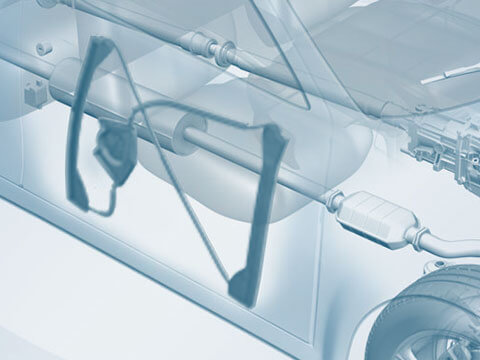Body
The structure of a vehicle is referred to as its body. It is intended to accommodate and protect the vehicle occupants and any cargo.
Function
The body must satisfy numerous requirements. Firstly, it is the main design element of any given car. Secondly, it must satisfy various technical requirements. As a result, the body defines the space which is available for installing vehicle systems and components. Furthermore, the body must absorb all forces and torques, which necessitates stringent safety requirements.
Rigidity is achieved through the use of the compact body panels and hollow panel cross-sections whose profile areas – and thus section modulus – are as large as possible. Corrugation increases rigidity and the inherent oscillation frequency in order to prevent resonance and associated humming noises.
Self-supporting body
Nowadays, cars are mostly manufactured with self-supporting bodies. If the chassis and body of a particular vehicle are combined to form a single unit, this is referred to as a self-supporting body. This means that the body assumes the task of the frame: the axles and the powertrain are arranged on the body itself in such cases. The advantages of self-supporting bodies are the lower weight due to the omission of the frame, improved crashworthiness and more efficient utilisation of available space.
Materials
In the 1980s, vehicle bodies were still exclusively made of steel. Since then, the use of steel in modern bodies has reduced to a proportion of less than fifty per cent. Nowadays, materials such as aluminium, magnesium or plastics in a composite construction are increasingly used. The approximate weight saving achieved in doing so is between 10 and 20 per cent.
In addition, body components are optimised by varying sheet thickness in accordance with requirements: in such situations, so-called “tailored blanks” are comprised of varying sheet thicknesses and material quality levels. This enables certain areas of a component to be adapted to localised stresses.
Safety
The body must meet strict requirements in terms of safety. Optimum performance in all types of impact is an essential objective during the development phase. Above all else, this is concerned with keeping the passenger compartment intact at all times. To mitigate the potential consequences of an accident, targeted deformations of body parts – such as the front-end structure and the longitudinal members in the event of a frontal collision – ensure that the energy released in the process is dissipated. The stresses to which the occupants are subjected are consequently reduced.
Protection of the environment
The use of lightweight materials and sophisticated lightweight construction concepts allow the gross weight of a car to be considerably reduced in certain cases. Fuel consumption and emissions can be reduced in doing so, which in turn reduces environmental pollution.



